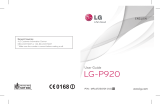
3
tal
Please read these simple
guidelines. Not following these
guidelines may be dangerous
or illegal.
Exposure to radio
frequency energy
THIS DEVICE MEETS
INTERNATIONAL GUIDELINES
FOR EXPOSURE TO RADIO
WAVES
Your mobile device is a radio
transmitter and receiver. It is
designed and manufactured
not to exceed the limits for
exposure to radio frequency (RF)
recommended by international
guidelines (ICNIRP). These limits
are part of comprehensive
guidelines and establish
permitted levels of RF energy
for the general population. The
guidelines were developed
by independent scientific
organisations through periodic
and thorough evaluation of
scientific studies. The guidelines
include a substantial safety
margin designed to assure the
safety of all persons, regardless
of age and health.
The exposure standard for
mobile devices employs a unit
of measurement known as
the Specific Absorption Rate,
or SAR. The SAR limit stated
in the international guidelines
is 2.0 W/kg*. Tests for SAR
are conducted using standard
operating positions with the
device transmitting at its highest
certified power level in all tested
frequency bands. Although
the SAR is determined at the
highest certified power level, the
actual SAR of the device while
operating can be well below the
maximum value. This is because
the device is designed to operate
at multiple power levels so as to
use only the power required to
reach the network. In general,
the closer you are to a base
station, the lower the power
output of the device. Before a
phone model is available for sale
Guidelines for safe and effi cient use
























